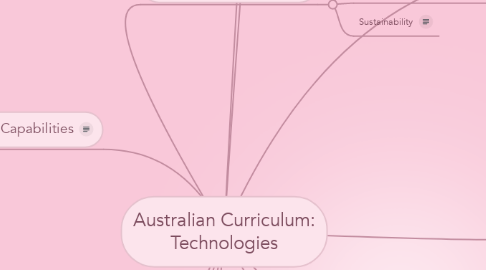
1. Key Concepts
1.1. Creating preferred ideas
1.2. Project management
1.3. Thinking in technologies
1.3.1. System thinking
1.3.2. Design thinking
1.3.3. Computational thinking
2. Subjects
2.1. Design and Technologies
2.1.1. Knowledge and understanding
2.1.2. Processes and production skills
2.1.2.1. Investigating
2.1.2.2. Generating
2.1.2.3. Producing
2.1.2.4. Evaluating
2.1.2.5. Collaborating and managing
2.2. Digital Technologies
2.2.1. Knowledge and understanding
2.2.2. Processes and production skills
2.2.2.1. Defining
2.2.2.2. Designing
2.2.2.3. Implementing
2.2.2.4. Evaluating
2.2.2.5. Collaborating and managing
3. Aims and Objectives
3.1. Students are creative, innovative and enterprising when using traditional, contemporary and emerging technologies.
3.2. Effectively and responsibly select and manipulate appropriate technologies.
3.3. Critique, analyse and evaluate problems, needs or opportunities to identify and create solutions.
4. General Capabilities
4.1. Literacy
4.2. Numeracy
4.3. Information and communication technology (ICT) capability
4.4. Critical and creative thinking
4.5. Personal and social capability
4.6. Ethical understanding
4.7. Intercultural understanding
5. Student Diversity
5.1. Students with disability
5.2. English as an additional language or dialect
5.3. Gifted and talented students
6. Cross-curriculum Priorities
6.1. Aboriginal and Torres Strait Islander histories and cultures
6.2. Asia and Australia’s engagement with Asia
6.3. Sustainability
7. Content Descriptors
7.1. Digital technologies
7.1.1. Knowledge and understanding
7.1.1.1. Digital systems
7.1.1.2. Representation of data
7.1.2. Processes and production skills
7.1.2.1. Collecting, managing and analysing data
7.1.2.2. Defining
7.1.2.3. Designing
7.1.2.4. Implementing
7.1.2.5. Evaluating
7.1.2.6. Collecting and managing
7.2. Design and technologies
7.2.1. Knowledge and understanding
7.2.1.1. Technologies and society
7.2.1.2. Technologies contexts
7.2.1.3. Engineering principles and systems
7.2.1.4. Food and fibre production
7.2.1.5. Food sepcialisations
7.2.1.6. Materials and technologies specialisations
7.2.2. Processes and production skills
7.2.2.1. Investigating
7.2.2.2. Generating
7.2.2.3. Producing
7.2.2.4. Evaluating
7.2.2.5. Collaborating and managing
8. Band Levels
8.1. Primary
8.1.1. Foundation to year 2
8.1.2. Year 3 and 4
8.1.3. Year 5 and 6
8.2. Secondary
8.2.1. Year 7 and 8
8.2.2. Year 9 and 10
9. Content Elaborations
10. Achievement Standard
10.1. Foundation to year 2
10.1.1. Digital technologies
10.1.1.1. Identify how common digital systems (hardware and software) are used to meet specific purposes. They use digital systems to represent simple patterns in data in different ways.
10.1.2. Design and technologies
10.1.2.1. Describe the purpose of familiar products, services and environments and how they meet the needs of users and affect others and environments. They identify the features and uses of some technologies for each of the prescribed technologies contexts.
10.2. Year 3 and 4
10.2.1. Digital technologies
10.2.1.1. Describe how a range of digital systems (hardware and software) and their peripheral devices can be used for different purposes. They explain how the same data sets can be represented in different ways
10.2.2. Design and technologies
10.2.2.1. Explain how products, services and environments are designed to best meet needs of communities and their environments. They describe contributions of people in design and technologies occupations. Students describe how the features of technologies can be used to produce designed solutions for each of the prescribed technologies contexts.
10.3. Year 5 and 6
10.3.1. Digital technologies
10.3.1.1. Students explain the fundamentals of digital system components (hardware, software and networks) and how digital systems are connected to form networks. They explain how digital systems use whole numbers as a basis for representing a variety of data types
10.3.2. Design and technologies
10.3.2.1. Describe some competing considerations in the design of products, services and environments taking into account sustainability. They describe how design and technologies contribute to meeting present and future needs.
10.4. Year 7 and 8
10.4.1. Digital technologies
10.4.1.1. Students distinguish between different types of networks and defined purposes. They explain how text, image and audio data can be represented, secured and presented in digital systems.
10.4.2. Design and technologies
10.4.2.1. explain factors that influence the design of products, services and environments to meet present and future needs. They explain the contribution of design and technology innovations and enterprise to society
10.5. Year 9 and 10
10.5.1. Digital technologies
10.5.1.1. Explain the control and management of networked digital systems and the security implications of the interaction between hardware, software and users. They explain simple data compression, and why content data are separated from presentation
10.5.2. Design and technologies
10.5.2.1. Explain how people working in design and technologies occupations consider factors that impact on design decisions and the technologies used to produce products, services and environments. They identify the changes necessary to designed solutions to realise preferred futures they have described.
